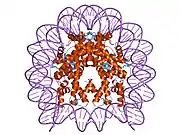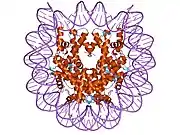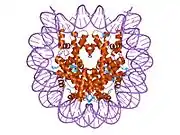HIST1H4F
Histone H4 is a protein that in humans is encoded by the HIST1H4F gene.[5][6][7][8]
Histones are basic nuclear proteins that are responsible for the nucleosome structure of the chromosomal fiber in eukaryotes. Two molecules of each of the four core histones (H2A, H2B, H3, and H4) form an octamer, around which approximately 146 bp of DNA is wrapped in repeating units, called nucleosomes. The linker histone, H1, interacts with linker DNA between nucleosomes and functions in the compaction of chromatin into higher order structures. This gene is intronless and encodes a member of the histone H4 family. Transcripts from this gene lack polyA tails but instead contain a palindromic termination element. This gene is found in the large histone gene cluster on chromosome 6.[8]
References
- GRCh38: Ensembl release 89: ENSG00000274618 - Ensembl, May 2017
- GRCm38: Ensembl release 89: ENSMUSG00000060678 - Ensembl, May 2017
- "Human PubMed Reference:". National Center for Biotechnology Information, U.S. National Library of Medicine.
- "Mouse PubMed Reference:". National Center for Biotechnology Information, U.S. National Library of Medicine.
- Albig W, Kardalinou E, Drabent B, Zimmer A, Doenecke D (Nov 1991). "Isolation and characterization of two human H1 histone genes within clusters of core histone genes". Genomics. 10 (4): 940–8. doi:10.1016/0888-7543(91)90183-F. PMID 1916825.
- Albig W, Kioschis P, Poustka A, Meergans K, Doenecke D (Apr 1997). "Human histone gene organization: nonregular arrangement within a large cluster". Genomics. 40 (2): 314–22. doi:10.1006/geno.1996.4592. PMID 9119399.
- Marzluff WF, Gongidi P, Woods KR, Jin J, Maltais LJ (Oct 2002). "The human and mouse replication-dependent histone genes". Genomics. 80 (5): 487–98. doi:10.1016/S0888-7543(02)96850-3. PMID 12408966.
- "Entrez Gene: HIST1H4F histone cluster 1, H4f".
Further reading
- Pauli U, Chrysogelos S, Stein G, et al. (1987). "Protein-DNA interactions in vivo upstream of a cell cycle-regulated human H4 histone gene". Science. 236 (4806): 1308–11. Bibcode:1987Sci...236.1308P. doi:10.1126/science.3035717. PMID 3035717.
- Albig W, Doenecke D (1998). "The human histone gene cluster at the D6S105 locus". Hum. Genet. 101 (3): 284–94. doi:10.1007/s004390050630. PMID 9439656. S2CID 38539096.
- El Kharroubi A, Piras G, Zensen R, Martin MA (1998). "Transcriptional activation of the integrated chromatin-associated human immunodeficiency virus type 1 promoter". Mol. Cell. Biol. 18 (5): 2535–44. doi:10.1128/mcb.18.5.2535. PMC 110633. PMID 9566873.
- Munakata T, Adachi N, Yokoyama N, et al. (2000). "A human homologue of yeast anti-silencing factor has histone chaperone activity". Genes Cells. 5 (3): 221–33. doi:10.1046/j.1365-2443.2000.00319.x. PMID 10759893. S2CID 20198031.
- Deng L, de la Fuente C, Fu P, et al. (2001). "Acetylation of HIV-1 Tat by CBP/P300 increases transcription of integrated HIV-1 genome and enhances binding to core histones". Virology. 277 (2): 278–95. doi:10.1006/viro.2000.0593. PMID 11080476.
- Deng L, Wang D, de la Fuente C, et al. (2001). "Enhancement of the p300 HAT activity by HIV-1 Tat on chromatin DNA". Virology. 289 (2): 312–26. doi:10.1006/viro.2001.1129. PMID 11689053.
- Strausberg RL, Feingold EA, Grouse LH, et al. (2003). "Generation and initial analysis of more than 15,000 full-length human and mouse cDNA sequences". Proc. Natl. Acad. Sci. U.S.A. 99 (26): 16899–903. Bibcode:2002PNAS...9916899M. doi:10.1073/pnas.242603899. PMC 139241. PMID 12477932.
- Yoon HG, Chan DW, Huang ZQ, et al. (2003). "Purification and functional characterization of the human N-CoR complex: the roles of HDAC3, TBL1 and TBLR1". EMBO J. 22 (6): 1336–46. doi:10.1093/emboj/cdg120. PMC 151047. PMID 12628926.
- Umehara T, Horikoshi M (2003). "Transcription initiation factor IID-interactive histone chaperone CIA-II implicated in mammalian spermatogenesis". J. Biol. Chem. 278 (37): 35660–7. doi:10.1074/jbc.M303549200. PMID 12842904.
- Lusic M, Marcello A, Cereseto A, Giacca M (2004). "Regulation of HIV-1 gene expression by histone acetylation and factor recruitment at the LTR promoter". EMBO J. 22 (24): 6550–61. doi:10.1093/emboj/cdg631. PMC 291826. PMID 14657027.
- Black BE, Foltz DR, Chakravarthy S, et al. (2004). "Structural determinants for generating centromeric chromatin". Nature. 430 (6999): 578–82. Bibcode:2004Natur.430..578B. doi:10.1038/nature02766. PMID 15282608. S2CID 4392941.
- Le XF, Lammayot A, Gold D, et al. (2005). "Genes affecting the cell cycle, growth, maintenance, and drug sensitivity are preferentially regulated by anti-HER2 antibody through phosphatidylinositol 3-kinase-AKT signaling". J. Biol. Chem. 280 (3): 2092–104. doi:10.1074/jbc.M403080200. PMID 15504738.
- Yoon HG, Choi Y, Cole PA, Wong J (2005). "Reading and function of a histone code involved in targeting corepressor complexes for repression". Mol. Cell. Biol. 25 (1): 324–35. doi:10.1128/MCB.25.1.324-335.2005. PMC 538779. PMID 15601853.







































